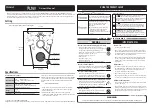
7 Maintenance
StamoSens CSM 750 / CSS 70
28
EHauser
7.2
Cleaning agent
Selecting the cleaning agent is dependent on the type of soiling. The most frequent
soilings and their associated cleaning agents are listed in the following table:
7.3
Calibration
The sensor calibration should be checked monthly. If necessary, recalibraton is required
after cleaning the optical window. The calibration can be carried out as one-point or
multiple-point calibration. For this, proceed as described in the initial start-up chapter
(
→
Chap. 6.2).
7.4
Checking cables and connections
Check the cables and connections according to the following checklist.
•
Check sensor cable for integrity, in particular the outer insulation.
•
If you are using a junction box: the box must be dry and clean inside.
Moist dehydrating bags must be replaced.
•
Tighten the terminals in the box.
•
Tighten the terminals in the device. Also check here whether the interior and terminals
are clean, dry and free of corrosion (if not: check seals and screw connections for
leak-tightness and integrity).
•
Cable screens must be connected exactly according to the wiring diagram. Screens
that are not connected or incorrectly connected can compromise the device’s
immunity to interference.
Type of soiling
Cleaning agent
Large residues
Cloth
Greases and oils
Agents containing tensides (alkaline) or water-soluble organic
solvents (e.g. alcohol)
Lime deposits, metal hydroxide
coatings, heavy biol. coatings
3...5 % HCl
Ultrafiltration cleaner (but never together with acid)
Sulphide deposits
Mixture of hydrochloric acid (3 %) and thiocarbamide (usual
commercial)
Ultrafiltration cleaner (but never together with acid)
Protein coatings
Mixture of hydrochloric acid (0.1 molar) and pepsin (usual
commercial)
Ultrafiltration cleaner (but never together with acid)
Light biological coatings
Pressurised water
Ultrafiltration cleaner (but never together with acid)
















































